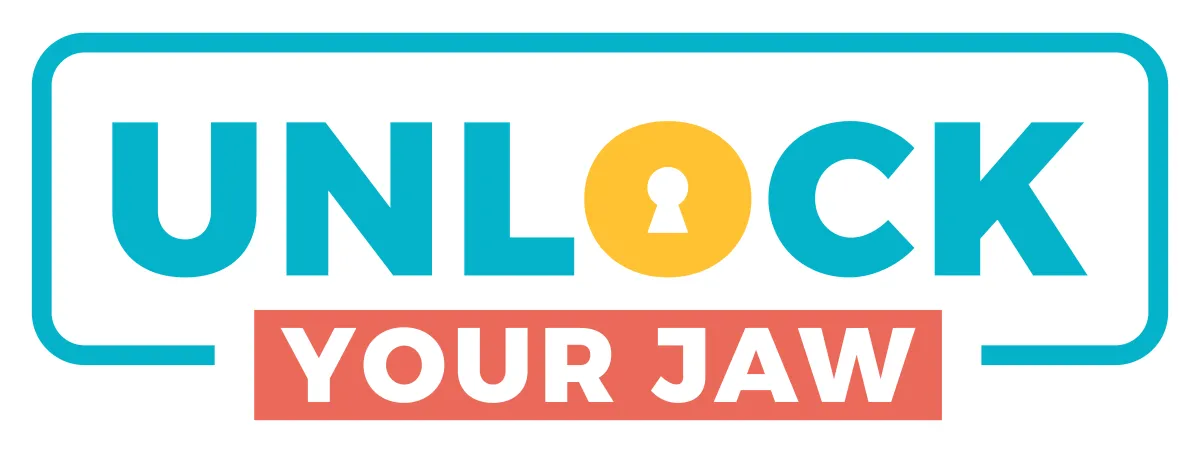Jaw Pain Isn't Just Stress or Teeth Grinding - It's a Nervous System Pattern.
Our 36-day guided approach shows you how to retrain your nerves and release jaw tension for good!
Tried Mouth Guards, Massage, Devices, And Still in Pain?
If your nervous system is stuck in tension mode, nothing else works.
Here's how to change that...and get your life back.
The Truth About TMJ: Why Most Treatments Fail -
and What Actually Works
What TMJ Really Means for Your Body
TMJ stands for temporomandibular joint disorders—also called TMD—and it affects how your jaw moves. This joint connects your jaw to your skull, and when it's out of balance, it can trigger a cascade of problems.
When your jaw stays tense, your nervous system stays locked in stress mode-making lasting relief impossible without retraining.
When things go wrong in this area, it's not just jaw pain-it can cause headaches, neck tension, and even impact your posture because your nervous system stays locked in a stress pattern.
Believe it or not, around 5 to 10% of people—about 11 million Americans—struggle with TMJ pain. And for many, it’s not just annoying… it’s downright debilitating.

TMJ affects more than just your jaw-it impacts your entire life.
Common TMJ Symptoms You Might be Ignoring
Jaw pain or tension
Headaches or migraines
Clicking or popping sounds
Jaw locking
Difficulty eating or speaking
Weight loss from pain
Why Most Treatments Fail and
What They're Not Telling You
Most common treatments for TMJ are backed by little to no solid science.
According to the TMJ Association, things like Botox injections and prescription drugs are often prescribed—even though the FDA hasn’t approved any medications specifically for TMJ disorders.
Pain meds? They’re either too weak to help or too addictive to rely on long-term. And that’s what makes this so frustrating for millions of people searching for relief.

Shocking Research & Expert Warnings
A 426-page report from the National Academies revealed that most healthcare providers receive little to no training on TMJ disorders. Patients are often harmed by overly aggressive care. Dr. Sean Mackey of Stanford called it ‘a quagmire.
He went on to say: “There is a perverse incentive in our society that pays more for things we do to people than for talking and listening to people. Some of those procedures, some of those surgeries clearly are not helping people.”
Real-Life Horror Stories
One woman had 24 TMJ-related surgeries by the time she turned 50—starting when she was just a teenager. She was pictured with her jaw wired shut after surgery in 2018.
Another patient was told to remove her jaw joints entirely and replace them with metal parts screwed into her skull. She developed a nickel allergy from the implants. The solution? More screws. She had to manually turn the screws each day to try to lengthen her jawbone. She was absolutely weeping as she described the horror she had to live through. I can’t even imagine.
What’s Being Done About It
So with all this pain, confusion, and failed treatments… what’s actually being done to fix TMJ?
The truth is, most traditional approaches focus on the jaw joint or even surgery - but success rates are shockingly low.
Even the head of the National Institute of Craniofacial Research (NIDCR), Dr. Rena D’Souza, has openly acknowledged the low success rate of TMJ surgeries and states that it is not very encouraging.
She’s calling for something that actually moves the needle.
They admit that they, as professionals have a profound lack of understanding about what’s really causing these problems.
Why? Because TMJ isn't just a 'jaw joint' problem.
It's a muscle and nervous system problem.
Until you retrain the nervous system and release the chronic tension patterns in your muscles, the pain cycle continues.
That's EXACTLY why I created Unlock Your Jaw-
to give you a proven, science-backed way to restore comfort and function
without invasive procedures or endless guesswork.
The Hidden Dangers of Ignoring TMJ Pain
It isn't just discomfort-it can spiral into serious health problems.
When TMJ is left untreated, it doesn't just stay in your jaw.
It can trigger a cascade of issues that affect your entire body and mind:
Tendonitis and arthritis in the jaw joint
Ringing in the ears and frequent headaches
Tooth damage and difficulty chewing, speaking, or even yawning
Sleep apnea and chronic pain
Anxiety, depression and emotional stress
Sleep apnea
Chronic pain
Anxiety and depression
Emotional stress
And frequent headaches
These problems don't just appear overnight-they build silently until they take over your life.
The good news?
You can stop this scycle before it starts.
That's why it's critical t take action now - and choose a solution that actually works.
What is Somatic Movement Exercises and why does it work?
The most effective and sustainable method
of reducing and even eliminating
neck tightness and pain is by
retraining the nervous system with
Somatic Movement Exercises.
You see, the more we repeat a specific posture or movement,
even if that posture or movement is something we intend to do, such as:
learning a new golf swing,
learning to ride a horse, or
learning to dance,
it creates a deeply learned pattern in our nervous system,
commonly known as ‘muscle memory.’
That muscle memory retains that level of tension doing us a favor
so we don’t have to work as hard to get into
that same habitual posture or movement again and again.
But sometimes it can get all WONKY
keeping those muscles contracted,
even when they're not supposed to,
and that's when pain shows up!
You can lose voluntary control of your muscles-
meaning they stay tight even when you think you're relaxed!
The good news is:
This muscle memory can be retrained
through a method called
pandiculation.
Pandiculation involves gently contracting a muscle or a muscle group
and then releasing it extremely slowly against gravity or some form of resistance.
This sends accurate biofeedback to the nervous system about how much tension is being held in the muscle in a process called the gamma loop feedback.
It resets the baseline level of tension in the muscles, thereby reducing the tension and pain!
Because pandiculation is an active form of learning, it is cumulative and sustainable.
Somatic Movement Exercises are taught in a specific order for each specific pain condition.
A recent study was conducted that supports Clinical Somatics Education as an effective and sustainable method of reducing pain.
My Recovery & Discovery

It was heartbreaking to hear the horror stories of those women. Because the solution I eventually found—actually worked. My major TMJ issues resolved after about nine months, but I still had lingering symptoms. Clicking and popping in my jaw.
Moments where I could feel the tension creeping back in. And honestly? It gave me anxiety, especially before dentist appointments.
After years of pain, I discovered Clinical Somatic Education—a method that retrains
your nervous system and releases chronic tension. These gentle movements changed everything for me.
How It Works
To truly relieve TMJ pain, you have to address the entire pattern of tension in your
body—not just your jaw. Clinical Somatic Education uses a technique called
pandiculation to reset your nervous system and release chronic muscle tension.
It’s a method of neuromuscular education developed by Thomas Hanna. He created self-care exercises using a technique called pandiculation which helps release chronic, involuntary muscle tension and retrain the nervous system.


Somatic Movement Exercises involve your active participation, which is key to your success - you consciously move specific parts of your body as guided, engaging your awareness and control.
By doing this, you are retraining your nervous system to release the chronic muscle tension, thereby bringing you the pain relief you’ve been looking for.
Stretching, tools or devices like foam rollers, or even approaches like injections, chiropractic care, physical therapy, and even surgery do NOT address the underlying cause of TMJ.
They simply do not address the root cause and cannot reset the baseline level of muscle tension

How I Went From Jaw Pain and Hopelessness to Living Pain-Free
Let me tell you how I went from living with TMJ pain to living pain-free—and how you can too.
It was Thanksgiving Day. I was sitting at the dinner table with my family, fork in hand, ready to dive into mashed potatoes. But my jaw was locked. I couldn’t open my mouth wide enough to eat. It was miserable. I couldn’t enjoy the holiday, the food, or the company.
And I kept asking myself—how did this even happen? After years of never having dental issues, I suddenly needed a root canal and a crown. That one procedure led to months of severe TMJ pain.
I had headaches, blurry vision, weight loss, and even social anxiety because I couldn’t partake in conversations or even eating. I started feeling hopeless—like I’d never get out of pain. I went back to the dentist six times in two weeks, trying to get the crown adjusted so it wouldn’t feel like it was holding my mouth hostage. I saw my chiropractor, got regular massages… all in an attempt to relieve the tension. But nothing gave me lasting relief.
By learning how to Retrain your nervous system you can Transform your life with these results:

Take control over your pain instead of being a victim to your pain

Free yourself from the fear of remaining in pain or falling back into pain

Enjoy the activities you gave up due to the pain

Take control over your pain instead of being a victim to your pain

Free yourself from the fear of remaining in pain or falling back into pain

Enjoy the activities you gave up due to the pain
These are just a few of the real-life benefits our students experience after completing the courses.
You’re Just 1 Click Away From Your
Painful to Pain-Free Transformation.
Begin Your Unlock Your Jaw Journey Now!

Here’s A Recap of EVERYTHING You’ll Get When You Start Your Pain Transformation Journey!
UNLOCK YOUR JAW course:
12 video lessons of somatic movement demonstrations in a specific order for “Unlock Your Jaw”
2 hours and 20 minutes total of somatic movement instruction (takes less time to practice) over 36 days
PDF downloadable instructions in each lesson for your home practice
Free Gift #1: Breathing Exercises included in first lesson – Lower Belly Breathing is an important aspect of many of the somatic movements. It will help you take your time with the movements and allow your muscles to release all tension.
Free Gift #2: Access to a Private Community where you can share your experiences with others as you go through this painful to pain-free journey.
Total Value: $2550
Normal Price: $1997
Special Launch Price: $497


Copyright Midwest Somatics And Wellness, LLC 2025. All rights reserved